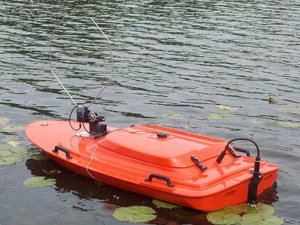University of Minnesota robots to join search for invasive species

$2.2 million grant to fund development of robotic boats to track nonnative carp
Contacts:
Rhonda Zurn, College of Science and Engineering, rzurn@umn.edu, (612) 626-7959
Preston Smith, University News Services, smith@umn.edu, (612) 625-0552
Media note: View video of prototype robotic boats in action at z.umn.edu/carptracker
MINNEAPOLIS / ST. PAUL (10/17/11) – Computer scientists and biologists from the University of Minnesota and two other universities are teaming up with robots to tackle a major invader of rivers, wetlands, lakes across the United States—the common carp.
Researchers from the University of Minnesota, Johns Hopkins University and Central State University in Ohio have been awarded $2.2 million from the National Science Foundation (NSF) to develop robotic boats and train them to locate and follow radio-tagged carp as part of a new approach to controlling populations of the nonnative fish.
The team is led by computer science and engineering associate professor Volkan Isler in the University of Minnesota’s College of Science and Engineering and resident fellow of the Institute on the Environment. He is joined by computer science and engineering associate professor Stergios Roumeliotis, also from the College of Science and Engineering, and fish biology professor Peter Sorensen from the University of Minnesota’s College of Food, Agricultural and Natural Resource Sciences.
“The project touches a lot of very difficult theoretical robotics problems I’ve been working on for 10 years,” Isler said. “At the same time, it allows us to do something useful for society so I’m very excited about it.”
Introduced from Eastern Europe more than a century ago, the common carp is a huge threat to lake and wetland health because adult carp uproot aquatic plants and foul the water with their bottom-feeding behavior. Hundreds of thousands of acres of waterfowl habitat and hundreds of Minnesota lakes have been lost to this species. Conventional control often involves large-scale use of poisons but rarely succeeds.
The robotic boats will be able to study carp movement patterns in large lakes and help develop attractants so this species can be located when adult carp form large groups that swim together, called shoals. Sorensen’s laboratory has already discovered that when carp form huge shoals they can be netted and removed with very high efficiency. However, finding and controlling these aggregations from conventional boats is expensive and nearly impossible.
The project is an offshoot of work Isler began several years ago with Sorensen. The two used funding from the University of Minnesota’s Institute on the Environment and the Environmental and Natural Resources Trust Fund to build and test a prototype robotic boat. Using the new NSF funds, the project team will develop the next generation of the technology, in which multiple robots will collaborate to quickly find and accurately localize the fish. They will then deploy the robots in Minnesota and eventually in larger and more remote regions where control is especially difficult. The Malheur National Wildlife Refuge in Oregon, which was founded by Teddy Roosevelt for migrating birds that use the Pacific flyway but is now overrun by carp, is of special interest.
Isler eventually plans to install solar panels on the robotic boats so they can be self- powered. He also hopes to apply robotics technology to a variety of other natural resource management challenges, such as water and soil quality monitoring.
His long-term plans are even loftier: to build a system for what he calls “Googling the Planet” (an idea he came up with co-investigator Andreas Terzis from Johns Hopkins University) that will allow scientists and others to send questions about conditions to any point on the surface of the Earth and receive an answer from a robot positioned in the vicinity.
“Googling the Planet will enable scientists to query nature just like they query the Internet,” Isler says. “That’s the grand vision.”
For more information about the carp tracking project, visit the University of Minnesota Robotic Sensors Network Lab web page at z.umn.edu/carptracking.
